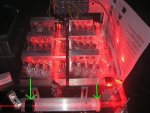IsaacT
0
- Joined
- Aug 25, 2010
- Messages
- 5,947
- Points
- 83
Ok guys, I have an idea that may sound crazy but I have been musing over it for quite a while. While I am planning on being a physics major, most of the detailed formulas are quite beyond my level right now and so I cannot seem to figure a solution out. Since yall have more experience with light and optics than me, I now turn to you.
What I want to do is to combine many powerful Laser Beams into one laser beam to maximize the power. Much like the build where you focus a bunch of the 1W projector diodes into a focal point, but here you wouldn't result in a spray of 1W beams diverging from the many Watt focal point. Instead there would be a many Watt beam that would be slightly less focused than the one with all of the diodes going in on a focus point and spreading out behind it. I have thought about prisms, I have thought about mirrors, hell, I even thought about magic (combine sesame!).
The only thing I could think of would be a many faceted prism that would have the light from every beam hitting a different face of the prism where the face and the angle of the beam were each designed to refract and focus towards the same spot at the end of the prism.
So you would have unique entry points, all designed so that the beam would be refracted to the same spot on the opposite end of the prism which would be a unified exit point. It would need very exact angles and the prism would be difficult to construct, granted, but if you could, would this work?
If not, do you have any other ideas? :bowdown:
What I want to do is to combine many powerful Laser Beams into one laser beam to maximize the power. Much like the build where you focus a bunch of the 1W projector diodes into a focal point, but here you wouldn't result in a spray of 1W beams diverging from the many Watt focal point. Instead there would be a many Watt beam that would be slightly less focused than the one with all of the diodes going in on a focus point and spreading out behind it. I have thought about prisms, I have thought about mirrors, hell, I even thought about magic (combine sesame!).
The only thing I could think of would be a many faceted prism that would have the light from every beam hitting a different face of the prism where the face and the angle of the beam were each designed to refract and focus towards the same spot at the end of the prism.
So you would have unique entry points, all designed so that the beam would be refracted to the same spot on the opposite end of the prism which would be a unified exit point. It would need very exact angles and the prism would be difficult to construct, granted, but if you could, would this work?
If not, do you have any other ideas? :bowdown:






